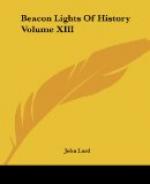“Seventeen,—a
rose of grace!
Girl never breathed
to rival such a rose!
Rose never blew
that equalled such a bud.”
A few songs of genuine Tennysonian harmony, pitched in the keys that most fittingly suit the singer’s mood, are interspersed through the drama, and serve to relieve the narratives of their gloom and plaint. Their presence, we cannot help thinking, recalls work better done, and more within the limitations of the poet’s genius, than this drama of “Queen Mary.” As a dramatic representation the drama had the advantage of being produced at the Lyceum Theatre, London, with all the historic art and sumptuous stage-setting with which Sir Henry Irving could well give it,—Irving himself personating Philip, while Miss Bateman took the part of Queen Mary. “Becket,” we should here add, was also given on the stage, and with much dramatic effectiveness, by Irving,—over fifty performances of it being called for. None of the dramas, however, as we have said, was a success, though each has its merit, while all are distinguished by many passages of noble and strenuous thought.
Other dramatic compositions the poet attempted, though of minor importance to the trilogy just spoken of. These were “The Falcon,” the groundwork of which is to be found in “The Decameron;” “The Cup,” a tragedy, rich in action, with an incisive dialogue, borrowed from Plutarch. The former was staged by Mr. and Mrs. Kendal, and had a run of sixty-seven nights; the latter also was staged with liberal magnificence, by Irving, and met with considerable success. “The Promise of May” is another play which was staged, in 1882, by Mrs. Bernard Beere, but met with failure by the critics, owing, in some degree, to its supposed caricature of modern agnostics, and to the repellent portrayal of one of the characters in the piece, the sensualist, Philip Edgar. Later, in (1892) appeared “The Foresters,” a pretty pastoral play, on the theme of Robin Hood and Maid Marian, which was produced on the boards in New York by Mr. Daly and his company, with a charming woodland setting. The later publications of the Laureate, in his own distinctive field of verse, embrace “The Lover’s Tale” (1879), “Ballads and other Poems” (1880), “Tiresias and Other Poems” (1885), “Locksley Hall Sixty Years After” (1886), “Demeter and Other Poems” (1889), and “The Death of Oenone, Akbar’s Dream, and Other Poems,” in the year of the Poet’s death (1892). In these various volumes there is much admirable work and many tuneful lyrics in the old charming, lilting strain, with not a few serious, thoughtful, stately pieces of verse, “the after-glow,” as Stedman phrases it, “of a still radiant genius.... His after-song,” continues this fine critic, “does not wreak itself upon the master passions of love and ambition, and hence fastens less strongly on the thoughts of the young; nor does it come with the unused rhythm, the fresh and novel cadence, that stamped the now hackneyed measure with a lyric’s name. Yet, as to its art and imagery, the same effects are there, differing only in a more vigorous method, an intentional roughness, from the individual early verse. The new burthen is termed pessimistic, but for all its impatient summary of ills, it ends with a cry of faith.”




